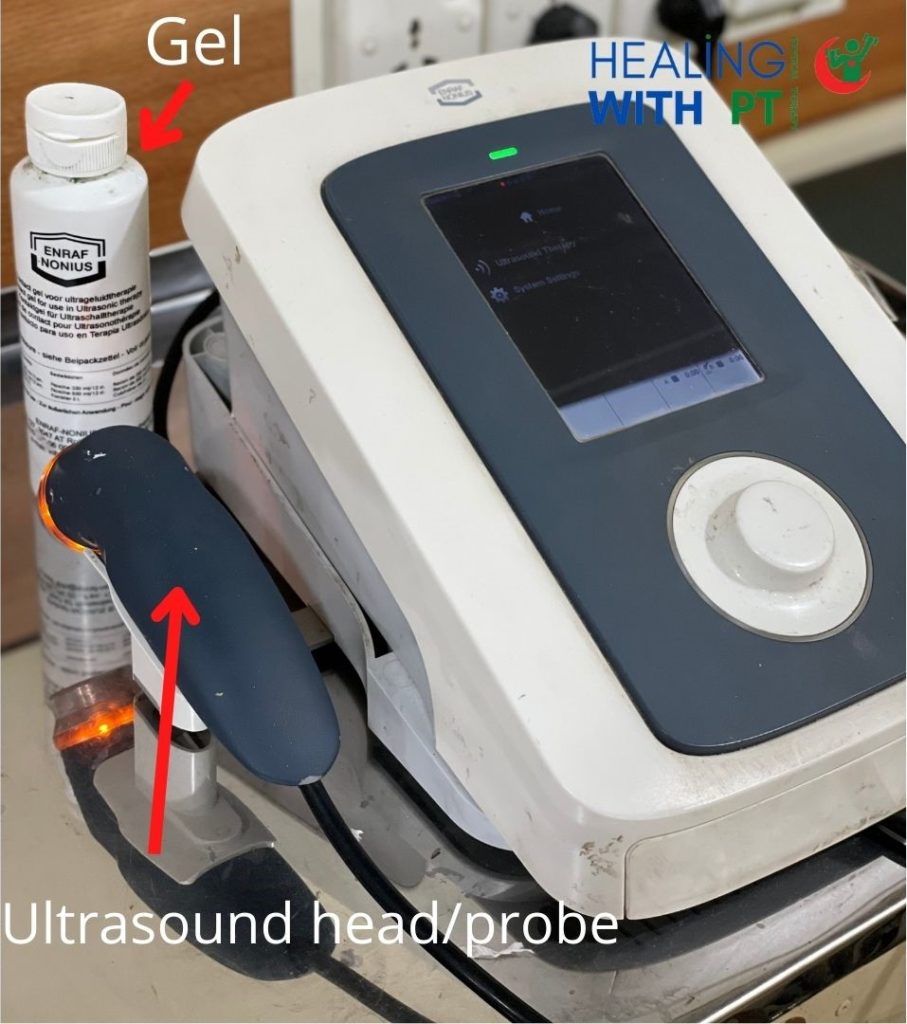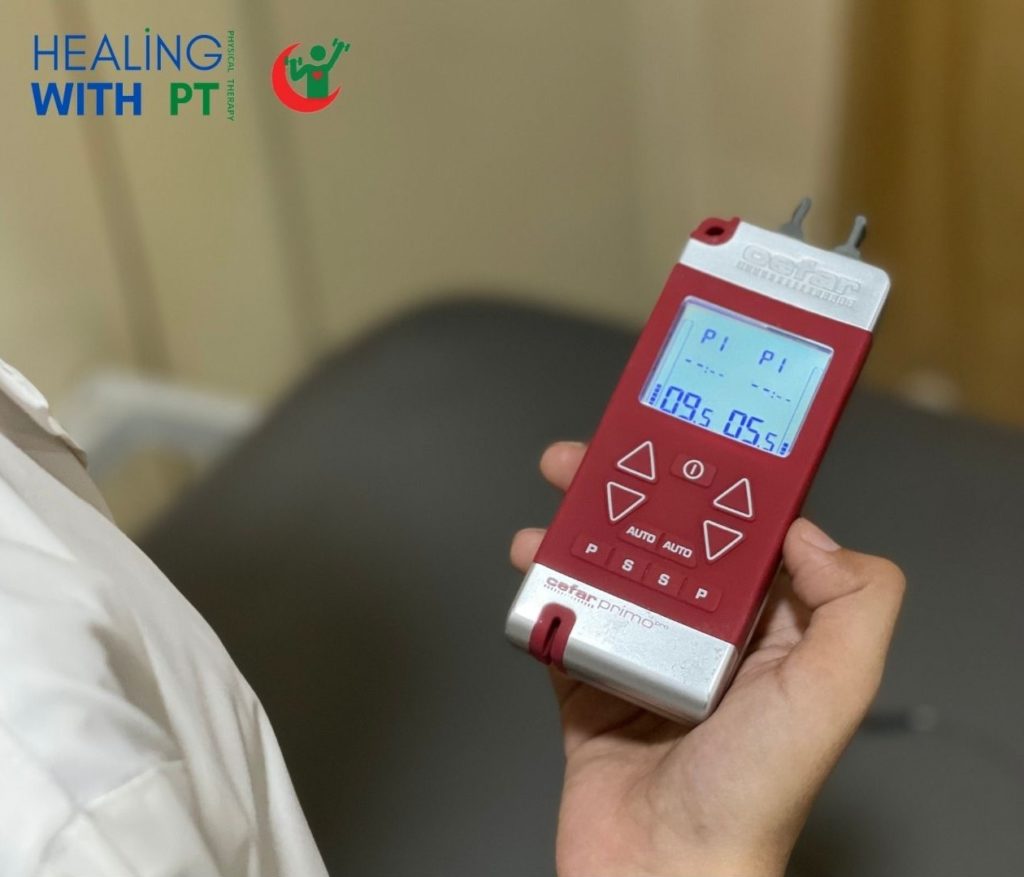Using machines to provide heat or sound waves to the muscles isn’t what comes to mind when you think of physiotherapy.
But such devices, called modalities or biophysical agents, are used in physiotherapy clinics globally.
Hence the question arises: why do you need them when physical therapy is active and exercise-based?
In this article, we’ll answer that question by introducing modalities to you and elaborating on the most common ones used in physiotherapy clinics along with their evidence-based and proven uses.
What Are Physiotherapy Modalities?
Physiotherapy modalities are electric, manual/mechanical, thermal, and sound energies that are used as therapeutic techniques along with active treatment approaches.
These aren’t advised for everyone. You have to pass certain criteria to become a good candidate for modalities. You could have the same diagnosis as someone who receives modality treatment, but not qualify for modalities yourself.
Current literature supports the use of different passive modalities in physical therapy but, again, it’s not all physio patients.
Physiotherapists are divided on whether or not modalities should be used for treatment.
That’s because some experts tend to overuse such modalities and extensively depend on passive techniques, which isn’t the best way to perform physical therapy because that can result in delayed recovery and unnecessarily prolonged treatment durations. (Reference)
Others have called these modalities placeboes because some researchers haven’t found them to be superior to exercises.
But we can’t declare all types of modalities as pseudoscience or placebo because of some studies. There’s still a large body of literature that proves the effectiveness of various modalities for specific patient populations.
It comes down to this: to enjoy the positive outcomes that these techniques can potentially provide, you have to use them for the intended purposes, according to the recommended guidelines, and only as an add-on to active physical therapy treatment and exercises, never as a stand-alone treatment.
5 Physiotherapy Modalities You’ll Find in a PT Clinic and Their Uses
Here are some electrotherapeutic modalities you’ll commonly find in physiotherapy clinics:
1. Therapeutic Ultrasound
Therapeutic ultrasound (TUS) is a treatment modality used in medicine and physical therapy.
We set the frequency of sound waves in kHz, intensity, and duration of the TUS therapy in the machine.
Then, we apply ultrasound waves via a transducer called the head or probe. Sound waves exit the head and into the skin and then tissues and muscles underneath it.
You need to have a gel medium between the probe/head and your skin. For that, we either use a propylene glycol-based gel or an analgesic cream.

Most Common Uses of Therapeutic Ultrasound in a Physiotherapy Clinic
Ultrasound helps the overall repair process by increasing inflammation by stimulating prostaglandins and leukotriene, which are inflammation-causing agents.
Hence it’s effective for tissues that have been damaged (acute or chronic injury) but the repair process has either not started, is too slow, or stopped prematurely.
Therapeutic ultrasound also increases fibroplasia and collagen synthesis, which is good for optimal scar formation.
We use ultrasound therapy to increase scar tissue mobility. It’s widely used to remodel scars in post-burned patients. The sound waves from the ultrasound head cause the molecules in the scar to oscillate and form new collagen fibers, leading to proper scar formation.
Ultrasound also helps with:
- Short-term musculoskeletal soft tissue pain management
- Treating frozen shoulder when used with stretching exercises and joint mobilizations
- Tennis elbow
- Reducing muscle contractures
- Releasing trigger points
2. Hot and Cold Pack
Thermotherapy and cryotherapy devices such as heating pads, heat wraps, ice packs, and cooling spray are used in nearly every single physiotherapy clinic. Both of these produce different biological responses.
Applying heat to the muscles or skin often helps to improve blood circulation and range of motion of joints and decrease muscle tightness.
On the other hand, cryotherapy helps to numb the area, decrease tissue excitability, and provide short-term pain relief.
Most Common Uses of Thermotherapy and Cryotherapy in a Physiotherapy Clinic
Warming an area before applying other physiotherapy modalities to it, such as exercises, helps with muscle relaxation and reduces joint stiffness. (Reference) That can increase patient participation during treatment and improve outcomes.
Ice packs are helpful to temporarily decrease the pain of bursitis, arthritis, and acute injuries.
People use cryotherapy for decreasing inflammation but the evidence suggests that doing so delays the healing process so you should use cryotherapy primarily for short-term pain management.
There are a lot of misconceptions about the uses of cold and heat therapy. It’s important to know exactly when these help so you can use them only for the intended purposes.
3. Electrical Stimulation Devices
Electric stimulation devices introduce small amounts of electric impulses in a specific region of your body. We place electrodes on the surface of your skin and adjust the current parameters in the e-stim device.
There are two main types: Transcutaneous Electric Nerve Stimulation (TENS) and Electric Muscle Stimulation (EMS). Both of these are set at different wavelengths and current frequencies.
The electric signals from the TENS machine disrupt nerve conduction and trick the brain into feeling less pain.
The electrical impulses from the EMS device stimulate movement in muscles similar to the active movements you perform by receiving signals from the brain.

Electrical stimulation is safe to use on humans. The current is controlled and you’re awake throughout the therapy duration to tell us if it becomes too much to handle. You’ll only feel tickles on your skin where the electrodes are attached.
Most Common Uses of Electrical Muscle Stimulation in a Physiotherapy Clinic
Electric muscle stimulation helps to move muscles that are paralyzed due to nerve damage such as after a stroke or a nerve lesion.
It reintroduces movement in the body in an attempt to teach the regenerating nerves specific movement patterns again while also teaching muscles to respond to the nerve signals, which are similar to the electric signals we provide through the EMS device.
The TENS machine sends signals that cause short-term pain relief by intercepting the pain signals passing through the nerves.
Sometimes, medication in gel form is placed between the electrodes and the skin to increase the absorption of the medication through iontophoresis.
Recently, e-stim was used in the rehabilitation of severe COVID patients who spent time in the ICU and suffered from muscle weakness.
Electric stimulation is effective for the treatments of:
- Urinary incontinence
- Poor muscle strength
- Nerve regeneration
- Post-stroke rehab
- Spinal cord injury
- Facial palsy or Bell’s palsy
4. Mechanical Traction Machine
Traction is a technique we use in physical therapy to decompress a joint or the spine.
You can do it manually, if the joint is small, such as the wrist or the knee, or use a machine if you’re looking to decompress a larger area.
The mechanical traction machine usually looks like a bed with breaks in between. We ask you to lay down on it and strap you in at multiple points.
Then, we set the machine to slightly move the different sections of the bed in opposite directions. That creates a space in your joints and decompresses them.
Most Common Uses of Mechanical Traction in Physiotherapy
Decompressing the spine causes short-term pain relief and symptom reduction. For example, muscle weakness due to nerve entrapment can be fixed by setting the nerve free through traction of the joint.
Here are some conditions we treat through mechanical traction:
- Pinched nerves
- Sciatica
- Neck pain due to nerve compression
- Pelvic pain
- Knee osteoarthritis
- Low back pain due to herniated disks (Reference)
5. Biofeedback Device
Biofeedback is a visual learning technique that we use to help patients improve movement patterns and modify involuntary activities.
The device we use is usually shaped like a pillow with a pressure gauge attached to it. When you press the pillow or squeeze it, you increase the pressure inside it, and that increase in pressure is shown by the movement of the needle of the gauge.
In simple words, you can visually see the force your muscles apply.
Most Common Uses of Biofeedback Devices in Physiotherapy
Biofeedback devices are used with patients who have a hard time understanding how much force they need to apply or how much muscle contraction is enough. It helps increase awareness and brings a conscious component to involuntary movements. (Reference)
We use it in pelvic floor physiotherapy to teach patients the proper way to contract muscles after surgery, childbirth, urinary incontinence, neck muscle training, weight-bearing, and core training.
The Takeaway
Physical therapy primarily involves exercises and manual therapy techniques. But modalities have a big role as well.
These augment our treatments and provide benefits that are difficult to achieve with hands-on physiotherapy alone. The most common positive outcomes of physiotherapy modalities are short-term pain relief and creating a healing-optimized environment.
It’s important to remember that modalities are rarely used independently. They are always used on top of an exercise and manual therapy regimen.
You can contact us if you’re interested in learning more about the uses of the aforementioned modalities and exploring if any of them can help you.
Disclaimer: This article is for informative purposes only. We provide well-researched and authentic information. Do not consider this personalized health advice. Please contact a licensed healthcare professional for medical issues and health concerns.